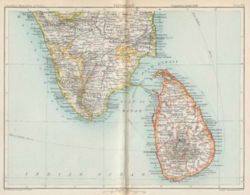Ceylon

"Ceylon, a large island and British colony in the Indian Ocean, separated on the N.W. from India by the Gulf of Manaar and Palk Strait. It lies between 5° 55' and 9° 51' N. and between 79° 41' and 81° 54' E. Its extreme length from north to south is 2 712 m.; its greatest width is 1371 m.; and its area amounts to 25,481 sq. m., or about five-sixths of that of Ireland. In its general outline the island resembles a pear, the apex of which points towards the north."[1] The island is now called Sri Lanka.
History
The Portuguese arrived in the early 16th century, followed by the Dutch in the 17th Century with the British, as usual, arriving late - 1796 - when the British East India Company established control. In 1802 Ceylon became a British Crown Colony. The island was unified in 1815 (previously there had been three kingdoms) and the island finally gained its independence in 1947.
Military actions
- War against Dutch in Ceylon -1795-96
- 1st Kandyan War - 1803-05
- 2nd Kandyan War - 1815
- 3rd Kandyan War (Uva Rebellion) - 1817-18
Records
Except for the few short years when the East India Company was in control (1796-1802) records for Ceylon will not be found in the India Office Records at the British Library, but at The National Archives at Kew. For example, the description and succession books of the Ceylon Rifles covering years 1809-1872 are held under reference W025/638-641 (these include officers services) and reference WO23/158 finds the admission books for rhe Ceylon Rifles and Gun Lascars for the period May 1868-Sept 1876.
Some information may be obtained by writing to Registrar General's Office, New Secretariat, Maligawatta, Colombo 10, Sri Lanka.
External links
- Ceylon Wikipedia
- The Virtual Library of Sri Lanka has a section "History", which in turn has a section "Colonial History, The British in Lanka (1796-1948)"
- Cemeteries in Ceylon books from Kabristan Archives-Old Irish and Indian Graveyards. Volume 1 is available through the FIBIS Online Bookshop
- Under a Tropical Sun (Macquarie University) covers 1796-1821. Includes the historical background and contemporary accounts of the Officers of the 73rd Regiment of Foot (and their families) in Ceylon 1814-21.
- History of Tea in Ceylon
- Genealogical Charts of Sri Lankan Burgher Families includes families with Portuguese, Dutch & British Colonial ancestry
- Sri Lanka Genealogy Website with links to the Rootsweb Sri Lanka Mailing List, to Rootsweb Sri Lanka Message Board and to GenForum Sri Lanka Message Board
Historical books online
- Coffee planting in Southern India and Ceylon by ECP Hull 1877 Archive.org